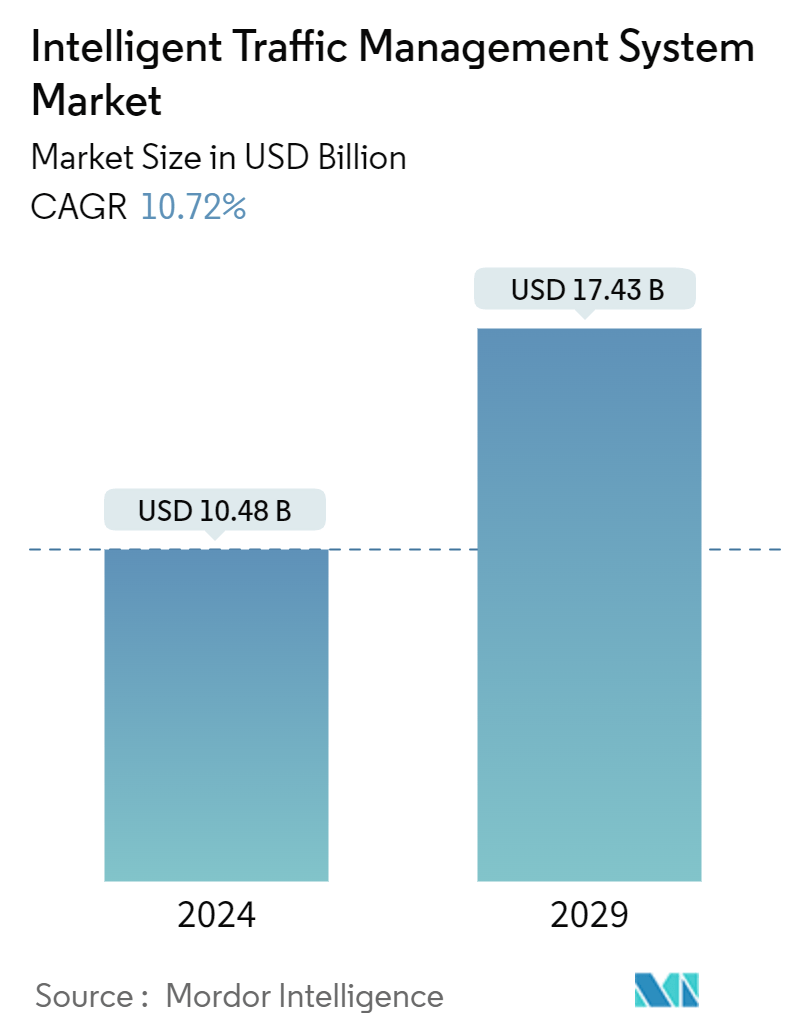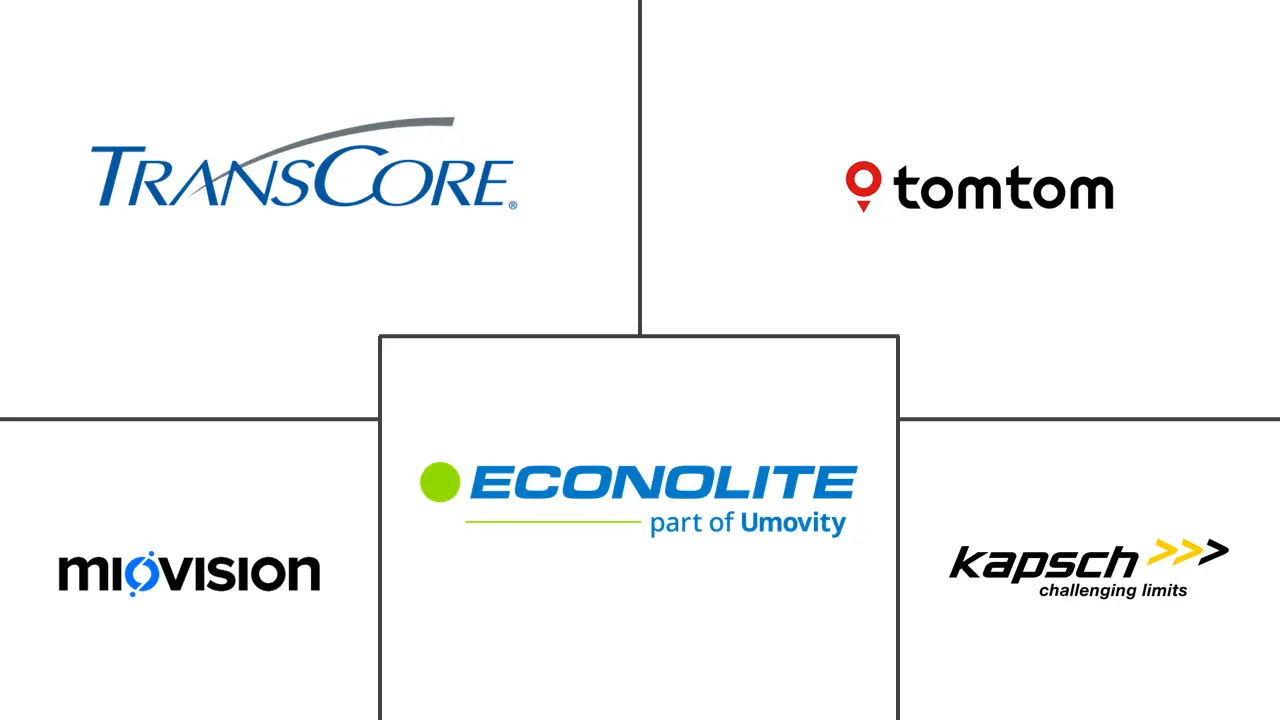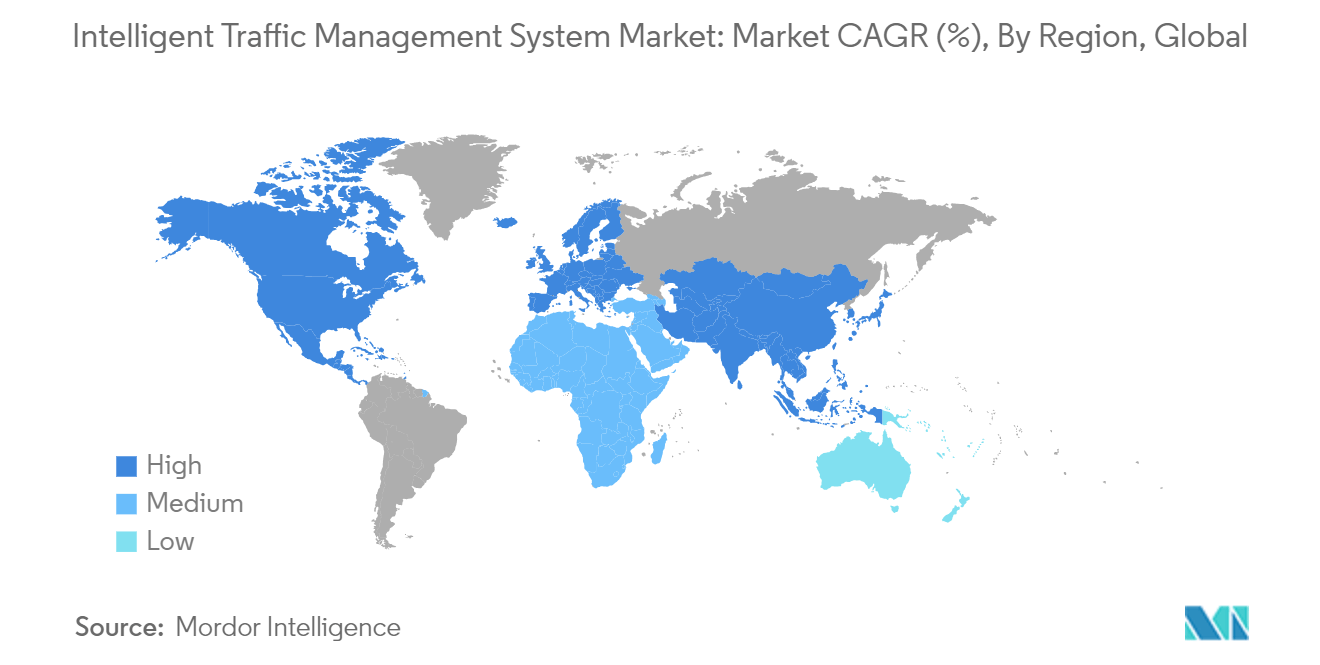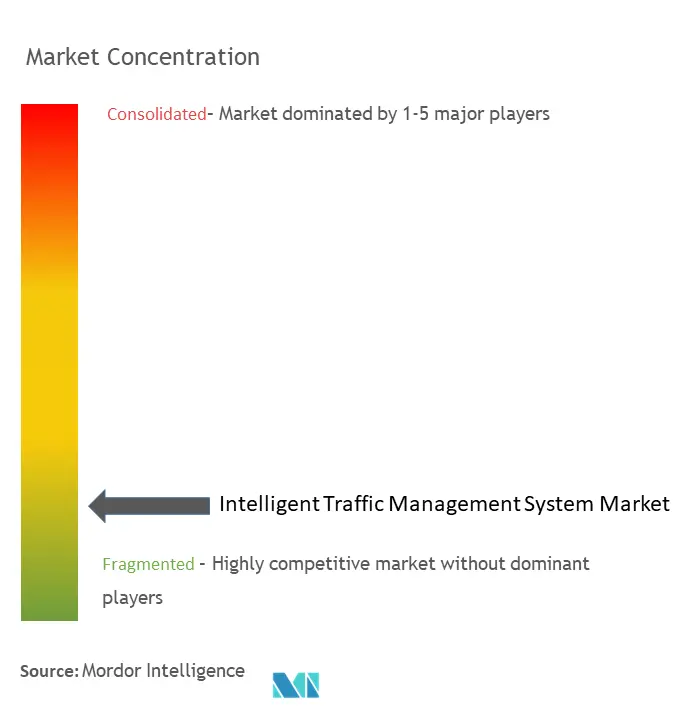Intelligent Traffic Management System Market Size

| Study Period | 2019 - 2029 |
| Market Size (2024) | USD 10.48 Billion |
| Market Size (2029) | USD 17.43 Billion |
| CAGR (2024 - 2029) | 10.72 % |
| Fastest Growing Market | North America |
| Largest Market | Asia Pacific |
Major Players
*Disclaimer: Major Players sorted in no particular order |
Intelligent Traffic Management System Market Analysis
The Intelligent Traffic Management System Market size is estimated at USD 10.48 billion in 2024, and is expected to reach USD 17.43 billion by 2029, growing at a CAGR of 10.72% during the forecast period (2024-2029).
- The rise of the Internet of Things (IoT) allows for connecting traffic signals, cameras, sensors, and vehicles, enabling real-time data collection and analysis. This connectivity enhances the effectiveness of intelligent traffic management systems. In addition, the proliferation of IoT devices in smart cities has led to higher demand for intelligent traffic management systems that can handle vast amounts of data from these devices and optimize urban services.
- In July 2024, Maharashtra's Pune Expressway is poised to roll out its inaugural AI-driven Intelligent Traffic Management System (ITMS). This pioneering system uses artificial intelligence and data analytics to optimize vehicle flow and enhance road safety. With its advanced capabilities, the technology automatically identifies a range of traffic violations, promising commuters a safer and more efficient journey. In response to a tragic accident on the Pune Expressway, where a bus carrying pilgrims collided with a tractor, resulting in the loss of five lives and injuries to 42 others, authorities have implemented an AI-powered ITMS.
- As cities become smarter globally, there is a growing demand for intelligent traffic management systems to manage the urban infrastructure efficiently, including traffic management, utilities, and public services. In June 2024, an Intelligent Traffic Management System (ITMS) worth INR 8.5 Crore will be implemented on the Bengaluru-Mysuru road network. The ITMS employs a network of 250 Automatic Number Plate Recognition (ANPR) cameras and 80 Red Light Violation Detection (RLVD) cameras strategically positioned at 50 crucial junctions. This advanced technology aids authorities in pinpointing traffic violations and enhancing overall road safety.
- As autonomous vehicles become more prevalent, the significant demand for intelligent traffic management systems increases. ITMS is crucial in managing mixed traffic environments where autonomous vehicles and human-driven share the road. An intelligent traffic management system is integral to vehicle-to-everything (V2X) communication and is essential for autonomous vehicles' safe and efficient operation in urban environments. In addition, citizens globally are increasingly demanding more efficient and reliable transportation systems. ITMS responds to these demands by reducing travel times and improving overall traffic conditions.
- Implementing an intelligent traffic management system requires significant investments in infrastructure, including installing cameras, sensors, communication networks, and data centers. These high costs can be prohibitive for smaller cities or regions with limited budgets. Furthermore, beyond the initial setup, ongoing maintenance costs can be high. Regular updates, repairs, and hardware and software replacements add to the long-term financial burden.
- Macroeconomic conditions like fluctuations in fuel prices can impact traffic patterns and the demand for intelligent traffic management systems. High fuel prices may reduce vehicle usage, lowering the urgency for intelligent traffic management systems, while low prices could have the opposite effect. Moreover, economic uncertainty, such as recessions or financial crises, can reduce public and private sector investment in new technologies, including the intelligent traffic management system.
Intelligent Traffic Management System Market Trends
Traffic Enforcement Cameras is Expected to Witness a Significant Growth
- The need for efficient and effective enforcement of traffic laws, such as speed limits and bus lane usage, is a significant driver of intelligent traffic management systems. Traffic management cameras provide a reliable, automated solution for monitoring and capturing traffic violations, reducing the reliance on manual enforcement by law enforcement officers.
- In addition, automated enforcement cameras lessen the potential for human error in monitoring and ticketing, which leads to more consistent enforcement of traffic laws. This reliability increases the adoption of intelligent traffic management systems as cities seek to improve traffic compliance.
- As public awareness of road safety issues increases, a growing demand for measures to reduce traffic violations and accidents is growing. Traffic enforcement cameras are vital in achieving these safety goals, driving demand for intelligent traffic management systems to deploy and manage these cameras effectively. Traffic enforcement cameras provide transparent, unbiased documentation of traffic violations, which can increase public trust in traffic law enforcement.
- Traffic enforcement cameras are crucial in reducing road accidents by deterring dangerous driving behaviors such as speeding and running red lights. The unique effectiveness of these cameras in improving road safety drives municipalities and transportation authorities to invest in comprehensive intelligent traffic management systems to integrate and manage these cameras effectively. Integrating traffic management cameras into centralized intelligent traffic management allows for coordinated traffic management across a city or region.
- In May 2024, Alders set the stage for the city to penalize speeding drivers and those who run red lights with traffic cameras. Less than a year after the state legislature enacted an enabling law in June 2023, the board unanimously passed an ordinance that legitimizes using traffic enforcement cameras. Additionally, they backed a plan for the city to position these cameras at 19 intersections, including nine outside schools. This proposal is now awaiting final approval from the Connecticut Department of Transportation.

Asia-Pacific is Expected to Hold a Significant Market Share
- Asia-Pacific rapidly adopts advanced technologies, including big data analytics and AI, to enhance traffic management. These technologies involve sensors, cameras, and connected devices for real-time traffic monitoring and management. Furthermore, as concerns about air pollution and carbon emissions rise, there's a heightened focus on alleviating traffic congestion and fostering sustainable transportation. Intelligent traffic management systems help optimize traffic flow, reduce idle time, and contribute to lower emissions.
- The significant economic growth in the region has led to increased infrastructure development, including roads, highways, and public transportation systems. Integrating intelligent traffic management systems in these projects is becoming more common to ensure efficiency and sustainable mobility. In addition, collaboration between governments and private companies is also a significant driver. These collaborations often focus on developing and implementing intelligent traffic management system solutions, accelerating its adoption across the region.
- In May 2024, Sikkim Authorities in India is set to roll out an AI-driven traffic management system. This innovative system seeks to modernize traffic oversight and enhance regulatory efficiency. By leveraging AI algorithms, the system will automatically verify essential documents, like insurance, tax, fitness, and pollution under control (PUC) certificates, and identify traffic violations, including speeding, signal jumping, and improper lane usage.
- High rates of road accidents and fatalities are promoting governments and municipalities in the region to seek advanced solutions to improve road safety. Intelligent traffic management systems offer tools such as automated traffic monitoring, real-time alerts, and incident detection systems that can help reduce the frequency and severity of accidents. In December 2023, road safety experts in New Delhi emphasized the urgent need for implementing an Intelligent Transport System (ITS) in India. As a developing nation, India faces a heightened risk of road accidents and fatalities, primarily attributed to escalating traffic congestion.

Intelligent Traffic Management System Industry Overview
The Intelligent Traffic Management Market is fragmented, with global conglomerates and specialized players operating across various segments. While several large multinational companies dominate certain high-value segments, numerous regional and niche players contribute to the overall competition, making the market highly diverse. This fragmentation is driven by the wide range of solutions offered for traffic signal control systems, traffic enforcement camera systems, traffic monitoring systems, and intelligent driver information systems.
Leading companies in the intelligent traffic management system market include Transcore Inc., TomTom International BV, Miovision Technologies Incorporated, Econolite Inc., Kapsch Trafficom AG, PTV Group, Q-Free Inc., Hitachi Limited, Dahua Technology Co Limited, Cubic Transportation Systems, Inc., and many others. These companies have established strong brand recognition and extensive global operations, enabling them to command significant market share. Their strengths lie in innovation, broad product portfolios, and strong distribution networks. These leaders often engage in strategic acquisitions and partnerships to maintain their competitive edge and expand their market reach.
To succeed in the intelligent traffic management system market, companies must prioritize innovation, especially in energy efficiency and environmental sustainability. The growing recognition of the significance of alleviating traffic congestion contributes to the demand for intelligent traffic management systems. Additionally, expanding service offerings and enhancing customer support will be crucial for maintaining long-term relationships and securing repeat business. Companies that invest in emerging markets and adapt their products to regional needs are likely to gain a competitive advantage in this fragmented market.
Intelligent Traffic Management System Market Leaders
-
Transcore Inc.
-
TomTom International BV
-
Miovision Technologies Incorporated
-
Econolite Inc.
-
Kapsch Trafficom AG
*Disclaimer: Major Players sorted in no particular order

Intelligent Traffic Management System Market News
- June 2024: TomTom (TOM2), a location technology company, partnered with Miovision, specializing in traffic management technologies. This partnership aims to enhance traffic signal analytics and in-vehicle solutions, ultimately reducing congestion and emissions while bolstering public safety. Miovision's innovations include the Audi Traffic Light Information system, a pioneering technology that guides drivers to bypass red lights at optimal speeds. By integrating TomTom's traffic data, Miovision's solutions will benefit from enriched real-time and historical traffic flow insights at intersections.
- March 2024: Thales partnered with Neural Labs, a provider of video analysis solutions for Smart Cities and AI-driven Intelligent Transportation Systems (ITS). This partnership aims to deliver efficient, secure, and significant solutions for vehicle access control and logistical planning. Leveraging Thales's Sentinel platform, which specializes in software licensing, entitlement management, delivery, and protection, Neural Labs has streamlined license creation and issuance automation.
- August 2024: CV Sync, one of the monitored traffic technology upgrades, Q-Free's advanced traffic management system (ATMS) harmonises traffic across nearly a dozen communities in California's Coachella Valley. The CV Sync project comprehensively overhauls the region's outdated signal controllers and traffic management systems. This upgrade integrates the latest, off-the-shelf Intelligent Transportation Systems technologies, incorporates cybersecurity measures, and establishes a new regional traffic management centre complemented by several local traffic operations centres.
Intelligent Traffic Management System Market Report - Table of Contents
1. INTRODUCTION
- 1.1 Study Assumptions and Market Definition
- 1.2 Scope of the Study
2. RESEARCH METHODOLOGY
3. EXECUTIVE SUMMARY
4. MARKET INSIGHTS
- 4.1 Market Overview
-
4.2 Industry Attractiveness - Porter's Five Forces Analysis
- 4.2.1 Bargaining Power of Suppliers
- 4.2.2 Bargaining Power of Consumers
- 4.2.3 Threat of New Entrants
- 4.2.4 Threat of Substitute Products
- 4.2.5 Intensity of Competitive Rivalry
- 4.3 Industry Value Chain Analysis
- 4.4 Impact of Macroeconomic Factors on the Market
5. MARKET DYNAMICS
-
5.1 Market Drivers
- 5.1.1 Government Initaives and Smart City Projects
- 5.1.2 Advancements in Technology Such as ML, AI, IoT
-
5.2 Market Restraint
- 5.2.1 High Initial Costs
6. MARKET SEGMENTATION
-
6.1 By Solution
- 6.1.1 Traffic Signal Control System
- 6.1.2 Traffic Enforcement Camera System
- 6.1.3 Traffic Monitoring System
- 6.1.4 Intelligent Driver Information System
-
6.2 By Component
- 6.2.1 Surveillance Cameras
- 6.2.2 Video Walls
- 6.2.3 Traffic Controllers and Signals
- 6.2.4 Others
-
6.3 By Geography***
- 6.3.1 North America
- 6.3.2 Europe
- 6.3.3 Asia
- 6.3.4 Latin America
- 6.3.5 Middle East and Africa
7. COMPETITIVE LANDSCAPE
-
7.1 Company Profiles
- 7.1.1 Transcore Inc.
- 7.1.2 TomTom International BV
- 7.1.3 Miovision Technologies Incorporated
- 7.1.4 Econolite Inc.
- 7.1.5 Kapsch Trafficom AG
- 7.1.6 PTV Group
- 7.1.7 Q-Free Inc.
- 7.1.8 Hitachi Limited
- 7.1.9 Dahua Technology Co Limited
- 7.1.10 Cubic Transportation Systems, Inc.
- *List Not Exhaustive
8. INVESTMENT ANALYSIS
9. FUTURE OF THE MARKET
** Subject To AvailablityIntelligent Traffic Management System Industry Segmentation
The Intelligent Traffic Management System is a solution that integrates real-time data analysis with advanced machine learning algorithms. The study tracks the revenue accrued through various players globally selling intelligent traffic management system types. The study also tracks the key market parameters, underlying growth influencers, and major vendors operating in the industry, which supports the market estimations and growth rates over the forecast period.
The Intelligent traffic management System market is segmented by solution (traffic signal control system, traffic enforcement camera system, traffic monitoring system, and Intelligent driver information system), component (surveillance cameras, video walls, traffic controllers and signals, and others), and geography (North America, Europe, Asia-Pacific, Latin America, and Middle East and Africa). The market sizes and forecasts are provided in terms of value (USD) for all the above segments.
| By Solution | Traffic Signal Control System |
| Traffic Enforcement Camera System | |
| Traffic Monitoring System | |
| Intelligent Driver Information System | |
| By Component | Surveillance Cameras |
| Video Walls | |
| Traffic Controllers and Signals | |
| Others | |
| By Geography*** | North America |
| Europe | |
| Asia | |
| Latin America | |
| Middle East and Africa |
Intelligent Traffic Management System Market Research FAQs
How big is the Intelligent Traffic Management System Market?
The Intelligent Traffic Management System Market size is expected to reach USD 10.48 billion in 2024 and grow at a CAGR of 10.72% to reach USD 17.43 billion by 2029.
What is the current Intelligent Traffic Management System Market size?
In 2024, the Intelligent Traffic Management System Market size is expected to reach USD 10.48 billion.
Who are the key players in Intelligent Traffic Management System Market?
Transcore Inc., TomTom International BV, Miovision Technologies Incorporated, Econolite Inc. and Kapsch Trafficom AG are the major companies operating in the Intelligent Traffic Management System Market.
Which is the fastest growing region in Intelligent Traffic Management System Market?
North America is estimated to grow at the highest CAGR over the forecast period (2024-2029).
Which region has the biggest share in Intelligent Traffic Management System Market?
In 2024, the Asia Pacific accounts for the largest market share in Intelligent Traffic Management System Market.
What years does this Intelligent Traffic Management System Market cover, and what was the market size in 2023?
In 2023, the Intelligent Traffic Management System Market size was estimated at USD 9.36 billion. The report covers the Intelligent Traffic Management System Market historical market size for years: 2019, 2020, 2021, 2022 and 2023. The report also forecasts the Intelligent Traffic Management System Market size for years: 2024, 2025, 2026, 2027, 2028 and 2029.
Intelligent Traffic Management System Industry Report
Statistics for the 2024 Intelligent Traffic Management System market share, size and revenue growth rate, created by Mordor Intelligence™ Industry Reports. Intelligent Traffic Management System analysis includes a market forecast outlook for 2024 to 2029 and historical overview. Get a sample of this industry analysis as a free report PDF download.



